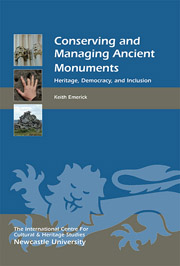Book contents
- Frontmatter
- Contents
- List of Illustrations
- Acknowledgments
- List of Abbreviations
- Introduction
- 1 The Restoration of Hellifield Peel and the Heritage Debate
- 2 The Origins of the Conservation of Ancient Monuments and the Beginnings of State Control in the United Kingdom
- 3 Practice Perfected: the Ancient Monuments Act of 1913 and the Consolidation of State Preservation Practice
- 4 British Conservation Practice in Cyprus, 1878 to 1939: a Case Study
- 5 Current Directions in England: the Emergence of Cultural Heritage Management and the Use of Conventions, Charters and Principles
- 6 Putting Theory into Practice
- 7 Conclusion: Ending the Tyranny of Ruskin and Morris?
- Appendices
- Bibliography and References
- Index
Introduction
Published online by Cambridge University Press: 05 August 2014
- Frontmatter
- Contents
- List of Illustrations
- Acknowledgments
- List of Abbreviations
- Introduction
- 1 The Restoration of Hellifield Peel and the Heritage Debate
- 2 The Origins of the Conservation of Ancient Monuments and the Beginnings of State Control in the United Kingdom
- 3 Practice Perfected: the Ancient Monuments Act of 1913 and the Consolidation of State Preservation Practice
- 4 British Conservation Practice in Cyprus, 1878 to 1939: a Case Study
- 5 Current Directions in England: the Emergence of Cultural Heritage Management and the Use of Conventions, Charters and Principles
- 6 Putting Theory into Practice
- 7 Conclusion: Ending the Tyranny of Ruskin and Morris?
- Appendices
- Bibliography and References
- Index
Summary
What can the burial of a number of modern concrete slabs at Fountains Abbey World Heritage Site tell us about the manner in which cultural heritage management practice operates in England?
Fountains Abbey is a ruined medieval monastic site near Ripon in North Yorkshire, England. The abbey complex is also part of a much larger designed landscape of the mid- and late 18th century. The designed landscape was initially created beyond the abbey grounds by John Aislabie, although the abbey ruins were later incorporated into the gardens by his son William, who extended the designed landscape. In the 19th century a Gothic Revival church was added to the large deer park which formed one part of the extensive garden. This designed landscape is referred to both as a ‘Water Garden’ and a ‘Pleasure Garden’. The entirety of the estate, abbey, water garden and deer park is known as Studley Royal and Fountains Abbey and was designated as a World Heritage Site in 1986. The ruined abbey complex is designated a nationally important archaeological site, while the garden contains numerous nationally important buildings and the designed landscape as a whole is a nationally important Historic Park and Garden.
Designation means that a place has been recognised by heritage experts as attaining a level of national or international importance against a set of agreed criteria and is deserving of particular consideration through the various planning and regulatory systems that exist nationally and internationally. Designation can exist at international level (as with World Heritage) but it also exists at national and local levels; most nations have their own list of those places considered to be ‘nationally important’ and which are designated as such. National importance is usually defined against criteria that recognise specific values or qualities, primarily: historical, architectural, aesthetic. The implication of this can be that certain qualities are privileged over others: the older something is the more important it is thought to be, whilst attribution (whether the place was conceived and designed by a famous person and is related to other comparable places) and aesthetics (the place as art history, its beauty and relationship to ‘high culture’) make major contributions to that sense of importance.
- Type
- Chapter
- Information
- Conserving and Managing Ancient MonumentsHeritage, Democracy, and Inclusion, pp. 1 - 12Publisher: Boydell & BrewerPrint publication year: 2014

